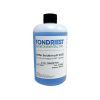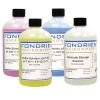Hach sensION+ 5051T Portable Combination pH Electrode
Features
- Low maintenance 3-in-1 design for samples with high solids content
- Protected against harsh field conditions
- Heavy-duty electrode handle design optimized for field calibration and storage
- Free ground shipping
- Expedited repair and warranty service
- Lifetime technical support
- More
Overview
The Hach sensION+ 5051T portable combination pH electrode has a glass body (protected by a plastic shroud), non-refillable solid-electrolyte reference and built-in temperature sensor. It has a fixed 1-meter cable and MP5 connector dedicated for use with Hach sensION+ Portable pH meters. The 5051T has an open annular junction with an integrated Pt1000 temperature sensor and is ideal for pH measurements in wastewater, foods, and other “dirty” samples with high solids content.
Mechanics
The Hach sensION+ 5051T Portable Combination pH Electrode calibration and storage tubes screw directly onto it's portable heavy-duty handle. This design is ideal for field calibration and transport as it provides a secure interface between the electrode and calibration/storage tube as well as reducing the risk of contamination in field conditions.
- Filling Solution: Non-refillable solid polymer
- Material Sensor Body: Glass
- Temperature Range: Continuous use: 0 - 80 °C
- Thermistor: Pt1000
- (1) Hach sensION+ 5051T Portable Combination pH Electrode
In The News
Ocean acidification: University of Washington's giant plastic bags help control research conditions
With oceans becoming more acidic worldwide, scientists are getting creative in designing experiments to study them. For example, one group at the University of Washington is using giant plastic bags to study ocean acidification. Each bag holds about 3,000 liters of seawater and sits in a cylinder-like cage for stability. The group at UW, made up of professors and students, is controlling carbon dioxide levels in the bags over a nearly three-week period, during which they are looking at the effects of increased acidity on organisms living near the San Juan Islands. “These mesocosms are a way to do a traditional experiment you might do in a lab or classroom,” said Jim Murray, professor of oceanography at the University of Washington.
Read MoreNOAA Alaska buoy network to monitor North Pacific ocean acidification
National Oceanic and Atmospheric Administration scientists detected signs of ocean acidification in the waters that hold the vulnerable and valuable fisheries of the North Pacific off the coast of Alaska, but they only had a snapshot of the action. “We know that in this place were important commercial and subsistence fisheries that could be at risk from ocean acidification,” said Jeremy Mathis, a NOAA Pacific Marine Environmental Laboratory researcher and professor at the University of Alaska Fairbanks. To understand how ocean acidification affects the North Pacific, NOAA scientists created a mooring network that collects constant in situ data on parameters contributing to acidification. They hope it will reveal seasonal trends and patterns left out by their snapshots.
Read MoreSafeguarding Communities with Real-Time Flood Monitoring in the City of Hazelwood
The City of Hazelwood is a suburb in St. Louis County, Missouri, home to around 25,500 people. Recently, the community has suffered increased flash flooding following severe storms, prompting the need for the installation of a flood monitoring system. In 2022, a NexSens X2 data logger was installed to monitor water level and rainfall in real-time, with the aim of reducing the loss of life and property as a result of extreme weather events. [caption id="attachment_39411" align="alignnone" width="940"] The latest flood event at Coldwater Creek, where the water level rose by 14 feet, exceeding the height of the X2 by three feet. The sensor can be seen behind the wall that usually contains the Creek.
Read More














